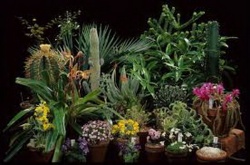Plants
Plants are living organisms which grow in the earth and have the ability to convert sunlight into the energy they need for growth. Buddhism considers plants to be one-facultied (ekindriya) life forms (Vin.III,155). The traditional way of classifying plants in ancient India was as medical herbs (osadhī), forest-type trees (vanaspati), fruit or flower-producing trees (rukkha), shrubs (gumba), grasses (tiṇa), plants with tendrils (patāna) and vines (vallī). The Buddha classified them according to whether they are propagated by roots, stems, joints, cuttings or seeds (D.I,5). While killing a plant would not be breaking the first Precept, the Buddha encouraged his disciples to have a respect for all life including plants and not to unnecessarily damage or destroy plants, their foliage or their seeds (D.I,5). See Flowers and Trees.
A Problem of the Sentience of Plants in Earliest Buddhism, L. Schmitthausen,1991.
